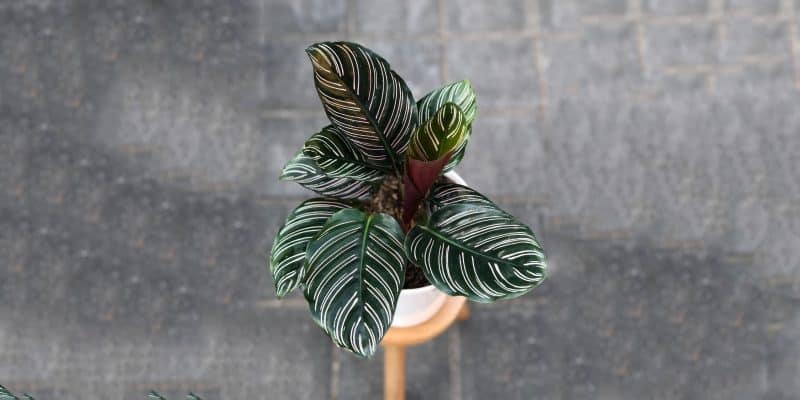With its dramatic dark-green leaves adorned with contrasting white and pink stripes, Calathea Ornata is a stunner. Plus, it’s a functional beauty, helping to purify the air in your home.
If you’ve heard horror stories about how fussy calatheas are, don’t worry. We’ll unravel the secrets of Calathea Ornata care and share our best tips for keeping it healthy and thriving.
Table of Contents
Calathea Ornata Care Guide
History, Habitat, and Characteristics
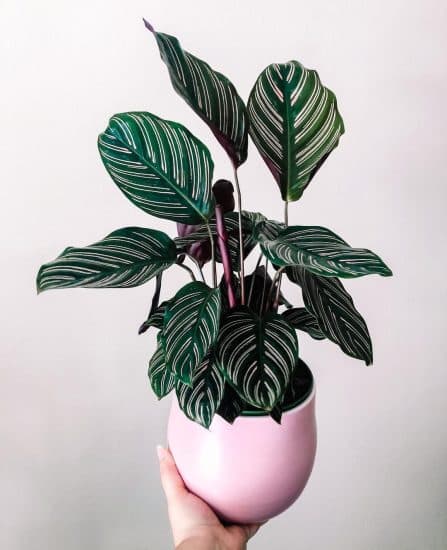
Calathea Ornata, pinstripe plant, or Pinstripe Calathea (what can I say, it’s a plant of many names) is an evergreen perennial that hails from the lush rainforests of South America, specifically Colombia and Venezuela.
These tropical plants are real showstoppers, with dramatic oval leaves that feature contrasting white or pink stripes against a backdrop of leathery green. This variegation helps the leaves absorb sunlight beneath the tropical canopy.
Calathea Ornata plants belong to the Marantaceae family, a group of heliotropic plants whose leaves move with the sun. Nicknamed the “prayer plant” family, some prayer plants have leaves that fold as if in prayer (I’m looking at you, . Others, like the pinstripe plant, only raise and lower their leaves during the day-night cycle.
Calathea Ornata reportedly also helps clean the air in your home. So it’s not just pretty to look at, it’s practical too, removing some toxins and making your space healthier.
Keep in mind that some Calathea species have recently been recategorized in the Goeppertia genus (I’m looking at you, Rattlesnake Plant and Peacock Plant). This means you’re likely to see the pinstripe plant referenced as Calathea ornata or Goeppertia ornata.
Light
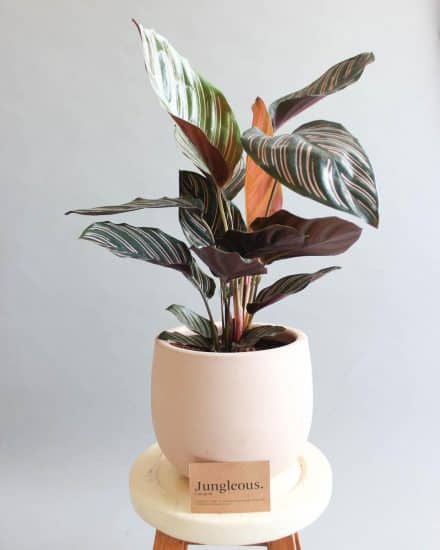
Out in the wild, calathea plants live under the shade of larger plants and trees, enjoying dappled light. To mimic these conditions, place your Calathea Ornata in a spot with low to medium indirect sunlight. Notice how the pink stripes on the leaves change to white when the light level increases a bit? You can use those stripes to tell if your plant is getting enough indirect sunlight.
Monitor your Calathea ornata plant for signs that it isn’t getting the right amount of light. For example, insufficient light may cause your plant to grow more slowly, as well as the leaves to lose their vibrancy and the pink or white stripes to fade. In this case, consider boosting with an LED full-spectrum light or moving your calathea plant to a brighter location.
Too much direct sunlight is a frequent problem too. Excess sunlight will make the leaves curl up, as if they’re hiding from the harsh sun, and it’ll also lead to crispy, brown leaf edges. To avoid excessive direct sunlight, use a sheer curtain to diffuse the light from a bright window.
It’s also a good idea to rotate your plant every few weeks to make sure every leaf gets an even share of light, keeping those stunning stripes in tip-top shape.
Water
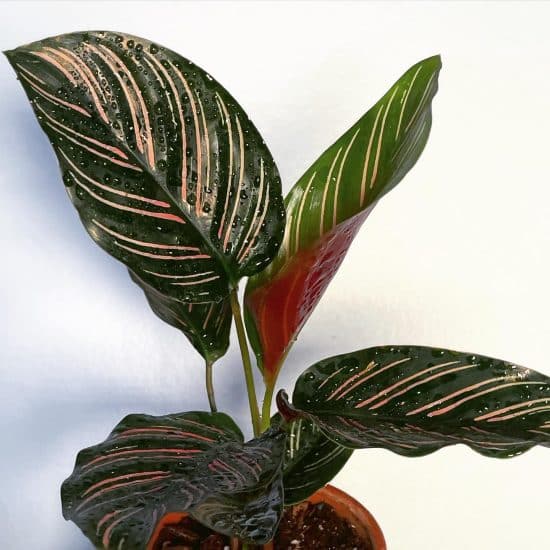
Calathea Ornata doesn’t need a ton of water, but its paper-thin leaves make it super important to find the right balance. It’s mostly fussy watering needs that give Calathea Ornata its reputation as a bit of a diva. Some people swear by avoiding tap water and only watering calathea plants with distilled water or rainwater.
The trick, though, if you can manage it, is to keep the soil moist but not soaking wet. It’s all about keeping an eye on that soil moisture. Give the soil a feel every day — when it’s dry, that’s your cue to water your precious calathea plant. If it still feels like a sponge that’s been gently squeezed out, wait another day and check again.
When the top inch or two of soil feels dry, it’s safe to water. Do so thoroughly throughout the growing season, until the water drains from the bottom. Cut down on watering during the dormant winter season, but you still don’t want completely dry soil to the point that the soil begins to separate from the pot.
If your Calathea Ornata isn’t getting enough water, the leaves will get brown edges and curl up. Remove any damaged leaves and increase your watering, but don’t overdo it. Remember — she’s a diva.
If you do overdo it, and your Calathea ornata gets too much water, she’ll throw a fit. Root rot is likely lurking just around the corner. If you see yellowing leaves and the soil just won’t dry out, hold off on watering for a bit, reevaluate your methods, and consider repotting in fresh soil.
Temperature and Humidity
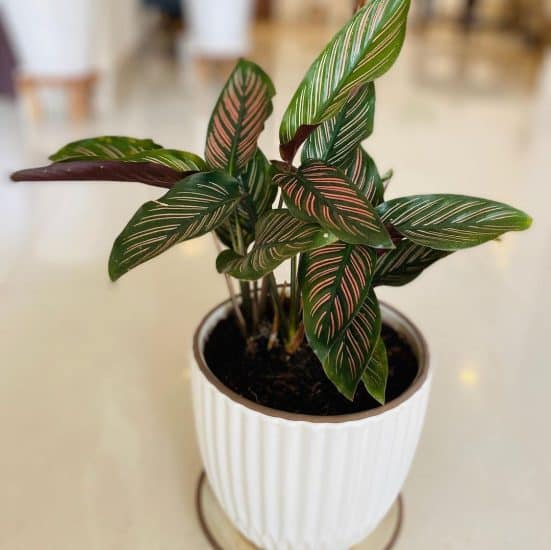
As tropical natives, calathea plants thrive in warm, humid environments similar to their natural environment. As such, aim for indoor temperatures between 65-80°F (18-26°C) to keep your calathea plant happy and healthy.
While it’s normal for temperatures to dip a bit at night, avoid exposing Calathea ornata to temperatures below 60°F, which could stress the plant and cause leaf damage.
Naturally, this tropical plant prefers humid environments ideally between 50% and 60%. To recreate the tropical climates of Columbia and Venezuela, run a humidifier near your plant for a few hours each day. You can also group it near other plants and place it on a pebble tray filled with just enough water to evaporate but not so much that the roots are sitting in excess water.
If you notice the leaves of your Calathea Ornata starting to curl or display brown edges, it’s likely that the humidity level is too low. Still, too much humidity can result in mold or mildew developing on the leaves or soil. Like I said, Calathea Ornata expects a delicate balance.
Soil and Planting
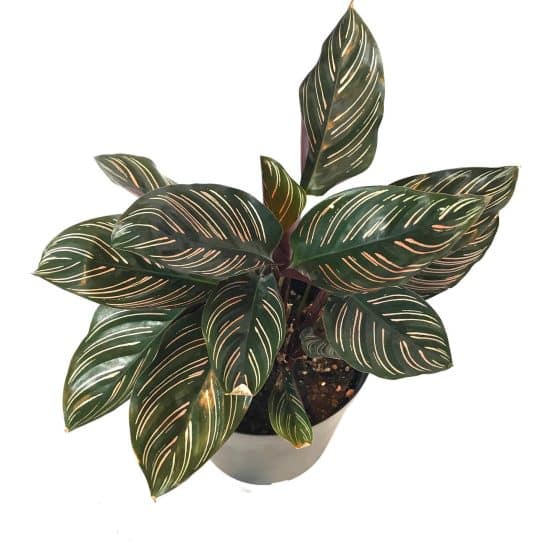
To achieve consistently moist soil, Calathea Ornata needs a well-aerated soil that retains moisture. To create the perfect environment for your calathea plant to thrive, you need to mimic a peat-based potting mix without actually using peat, which is seriously bad for the environment.
The perfect blend of soil starts with 2 parts high-quality potting soil, to 1 part each of coconut coir and perlite or coarse sand. The coconut coir results in a moist soil that never stays too wet because of the well-draining addition of perlite.
Using the wrong potting mix can result in yellow leaves, wilting, and slow growth. To resolve these issues, replace the potting mix with a loamy, well-draining mix that will promote moist soil and ensure proper aeration.
These signs can also indicate your Calathea Ornata plant is ready to be repotted. When repotting, choose a container that is slightly larger than the current one and has proper drainage holes. A drainage hole is a necessity, but other than that, you can use any plastic nursery pot that’s no more than a few inches wider and taller than the last pot.
Fertilizing
When it comes to fertilizing your Pinstripe Calathea, use a light fertilizer, such as a well-balanced organic fertilizer or compost tea, during spring and summer. Over-fertilizing can lead to detrimental effects on your plant’s health, such as leaf burn, brown tips, weak growth, and yellowing leaves.
To resolve over-fertilization issues, flush the soil with water, preferably distilled water or rainwater, to remove excess fertilizer and reduce the frequency of fertilizing. Moving forward, ensure that you dilute your fertilizer and only apply it during the growing season at the recommended rate.
Propagation Guide
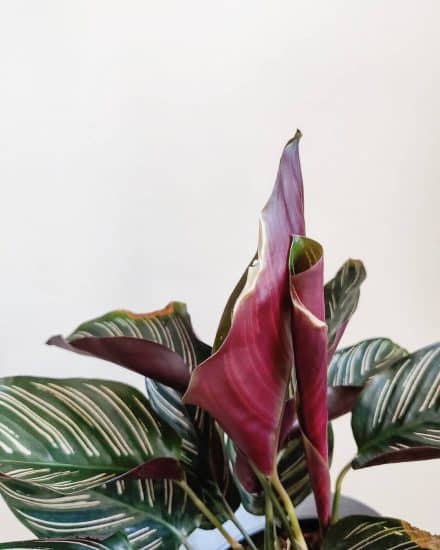
You can multiply your Pinstripe Calathea through root division, which is easily the simplest houseplant propagation method. It’s best to propagate plants in spring or early summer when they’re in active growth mode.
Propagating Calathea Ornata by root division:
- Gently take the Calathea Ornata out of its pot. Equally gently, loosen the soil around the pot’s roots to free them.
- Spread the root ball apart to spot healthy rhizomes with multiple growth points and healthy roots attached.
- Arm yourself with a clean, sharp knife or gardening shears, and carefully divide the rhizomes into sections. Ensure each section has at least one growth point, some roots, and foliage for a better shot at thriving.
- Prep new pots with a well-draining potting mix your Calathea Ornata will love. Plant each divided rhizome, cover the roots with soil, and gently pat it down. Give it a good soak and place it in a cozy, humid spot with bright, indirect light.
- Water your new plants as needed, making sure to keep the soil moist. In a few weeks, your plants should settle in nicely and start showing off some new growth.
Common Issues
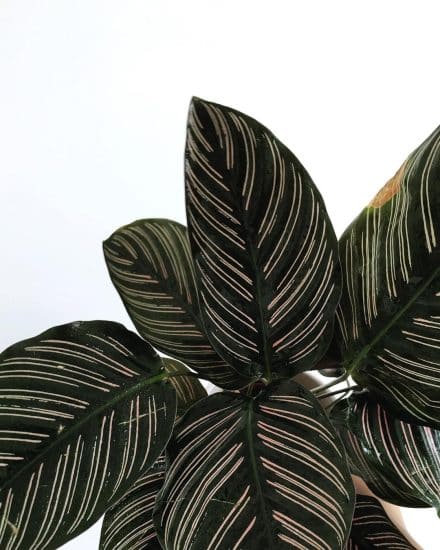
Crispy Leaf Edges
This may happen from both underwatering or overwatering your Calathea Ornata.
If you see a yellow line around those crispy edges, that’s a sign of overwatering. To solve this problem, make sure you’re using a well-draining soil and that you’re only watering when the top inch of soil feels dry.
No yellow? You’re probably underwatering. Wait until the top inch of soil feels dry, and then give your plant a good drink — just make sure the excess water can drain out!
Consistent watering is key, but be careful not to overdo it — soggy soil can lead to rot. Test the soil’s moisture before watering to make sure your calathea plant gets the perfect amount of water. Oh, and don’t forget the importance of humidity! Dry air, not just dry soil, can contribute to crispy leaf edges, too.
If you’re watering with tap water, you may want to switch to distilled water or rainwater. It may do nothing, but it can’t hurt.
Slow Growth
If your Calathea Ornata is displaying a lack of new growth, insufficient light could be the culprit. These beauties need bright, indirect light. Make sure your plant’s basking in a well-lit spot away from harsh direct sun.
Another thing to think about: the potting medium and nutrients. Slow growth might be due to nutrient deficiency, so be sure to add a balanced liquid fertilizer.
Slow growth may also indicate your Calathea ornata plant is ready for a larger pot. Repot your slow-growing friend in fresh soil and a slightly larger pot.
Pests
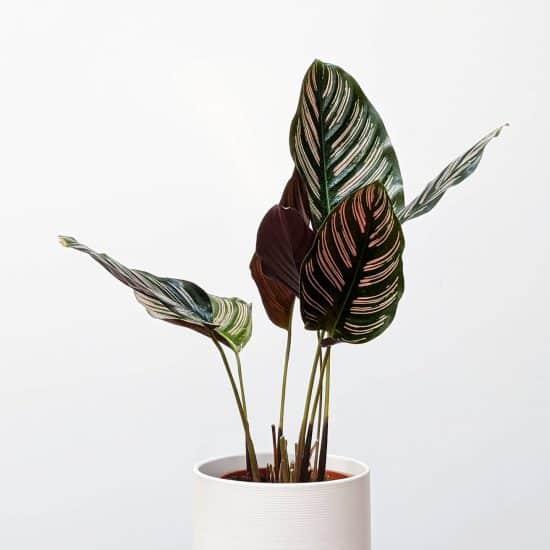
Calathea Ornata sometimes attracts fungus gnats and spider mites, common pests with equally common solutions.
Fungus Gnats
You know those tiny, dark-colored flying insects that love to buzz around your plants and crawl on the soil (or drown in your wine glass)? Yup, those are fungus gnats. The adults lay their eggs in damp soil, and the larvae munch on organic matter and roots, which can eventually lead to damage.
Diatomaceous earth, a powdery substance from fossilized algae, will kill them, but its efficacy dwindles when it gets wet — kind of a downside when you think about the Calathea Ornata plant’s watering needs.
The best course of action is to catch the adults with sticky traps placed in your soil and either replacing the top inch or two of soil where the larvae rest or completely repotting the plant in fresh soil, discarding the old soil.
To prevent gnats, avoid overwatering and root rot. You can also add a layer of sand or gravel on top of the soil, making it less appealing for those pesky gnats to lay eggs.
Spider Mites
Spider mites love low humidity and will suck the sap right out of your plant’s leaves! When spider mites attack, leaves can change color, become stippled, or even fall off. To identify them, look for fine webbing and minuscule, oval-shaped specks that move around on your plant.
First, manually remove the webs and bugs as best you can. Then, increase the humidity around your plant and apply neem oil or a miticide to all the plant’s surfaces, even the undersides of leaves.
To prevent spider mites from returning, maintain proper humidity, increase circulation, and keep an eye on your plant.
Conclusion
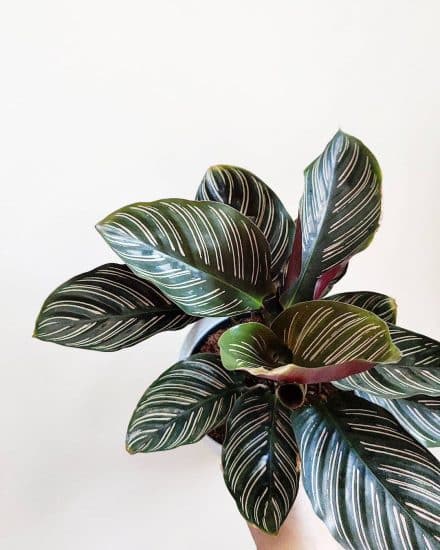
And that’s how you care for Calathea Ornata!
Pinstripe Calathea Care Summary:
- Provide bright, indirect sunlight and avoid direct sunlight.
- Keep the soil consistently moist but not soggy, and allow the top inch to dry out between waterings.
- Place your calathea in a warm environment with temperatures between 65-80°F and high humidity levels around 50%-60%.
- Use a well-draining potting mix and repot as needed to ensure healthy root growth.
Don’t hesitate to reach out if you have any questions or concerns about your Pinstripe Calathea.
If you found our care guide helpful, feel free to share it with fellow plant lovers or on social media. Spread the love for these pinstriped divas!
Happy growing!
FAQ
Is Calathea Ornata an indoor plant?
Absolutely! The Pinstripe Calathea is a fantastic indoor plant. Its striking foliage, with those stunning pink or white stripes, makes it a perfect addition to any indoor space.
As long as it’s provided with the right conditions — indirect light, consistent moisture, and a humid atmosphere — it’ll thrive indoors.
How big can a Calathea Ornata grow?
While the size of your Pinstripe Calathea will depend on factors such as lighting, humidity, and overall care, most Calathea Ornata plants can grow up to 2 feet tall, with a similar spread.
As a relatively compact plant, it fits well in any indoor space, whether it’s a cozy bedroom or an office desk. Just make sure it has enough room to spread its leaves and reach its full potential!
Does Calathea Ornata grow fast?
The growth rate of your Calathea Ornata will really depend on a few factors: lighting, humidity, proper care, and even the time of year! In general, these plants have a moderate growth rate, so don’t expect them to double in size overnight. They’ll put on most of their growth during the warmer months when they’re in their active growing phase.

